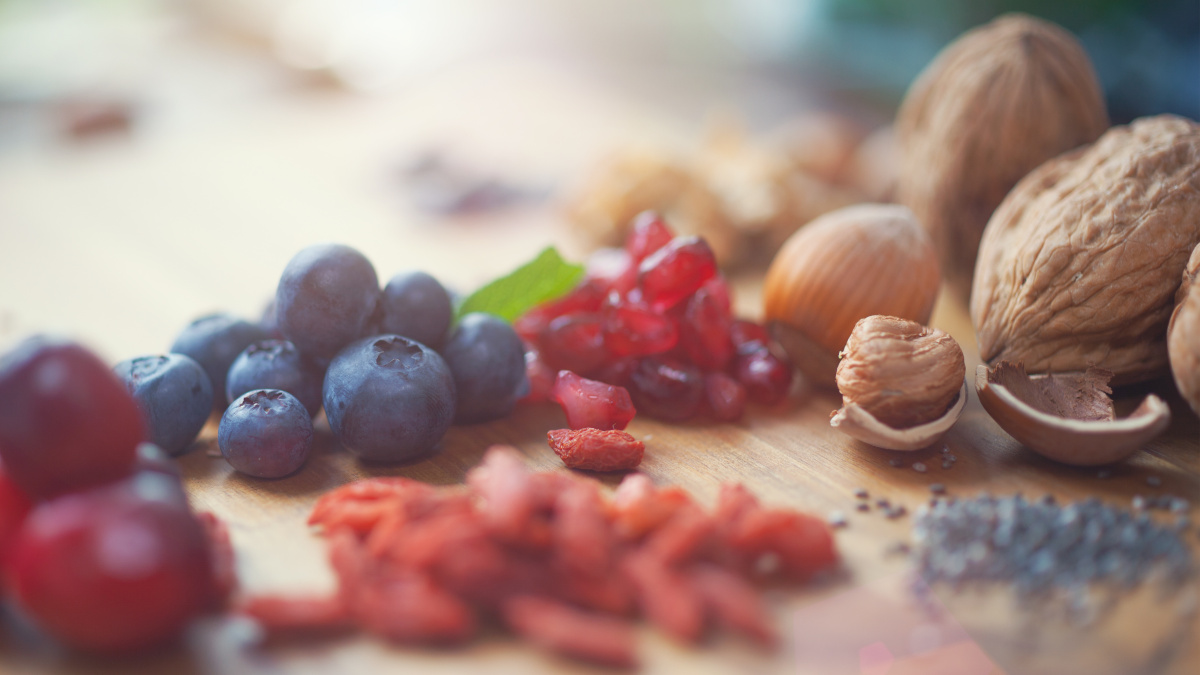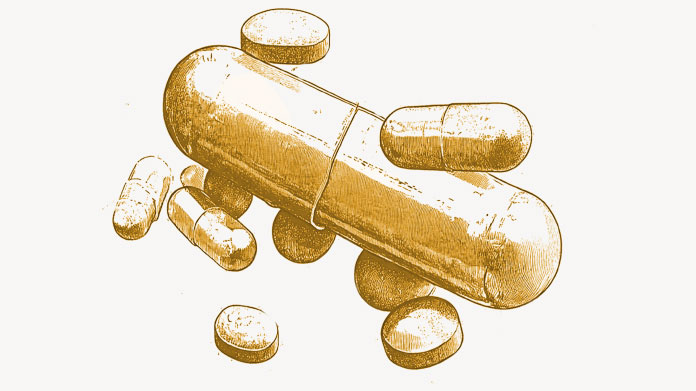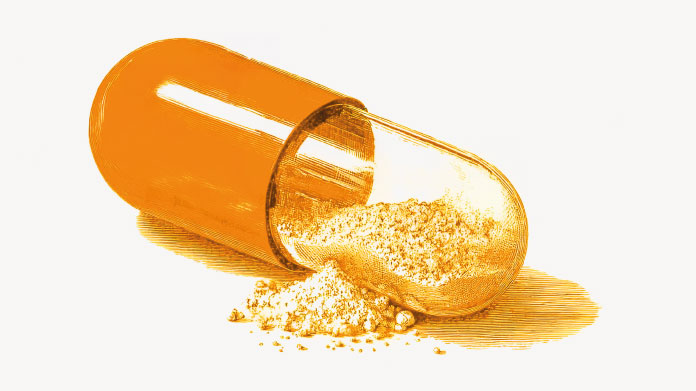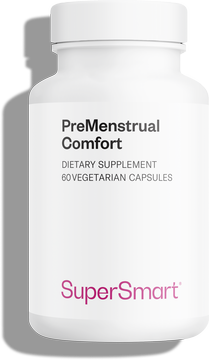The 7 best EFSA-certified superfoods
‘Superfoods’ are natural, health-beneficial foods with a high nutritional value. Which are the 7 best superfoods offering benefits validated by the European Food Safety Authority?

Spirulina, an exemplary superfood
Highly-bioavailable proteins, numerous minerals, carotenoids, vitamins A, B, E, K... Endowed with a truly exceptional nutritional content, spirulina is used in developing countries to fight malnutrition. Considered to be both algae and cyanobacteria, it grows best in warm water lakes in India, Chad and Mexico.
Spirulina helps to support the immune system, and maintain energy and vitality(1). It’s therefore an invaluable aid for people who are fatigued, overworked or who are convalescing. It also helps with weight control and appetite suppression (2).
The only drawback is that this impressive superfood absorbs various pollutants from its environment. If you’re thinking about taking spirulina, opt for a supplement produced using controlled aquaculture (such as Spirulina, an extremely safe supplement from Parry Organic Spirulina, the world’s best spirulina producer).
Garlic – the small clove that’s big on health benefits
Garlic fully deserves its reputation as a trusted home remedy. This small plant from the Alliaceae family supports good cardiovascular health and helps maintain normal blood cholesterol levels. It also supports good immune system function and has remarkable antibacterial properties (3).
Common white garlic is excellent, but black garlic is even better (4). Produced by fermenting heads of white garlic, it has a particularly high concentration of S-allyl-cysteine, a valuable organosulfur compound. It also contains polyphenols, flavonoids and selenium. What’s more, it won’t give you ‘garlic breath’ as it is allicin-free!
If you want to obtain its many benefits, choose a black garlic supplement (such as the product Organic ABG10+, an organic black garlic supplement standardized to 0.1% S-allyl-cysteine, the highest percentage on the market).
Set your sights on bilberries
Second World War pilots apparently ate them to help improve their vision on night flights, a move supported by modern science! With their antioxidant effects, bilberries (Vaccinium myrtillus) support visual health and function as well as playing a role in vein health (5-6). The remarkable effects of these extraordinary red berries come mainly from their content in anthocyanosides, also responsible for their beautiful dark purple color.
A bilberry supplement is an excellent idea if you want to get the full benefits of this compound’s many properties (try, for example Bilberry Extract, a wild bilberry supplement standardized to 25% anthocyanosides).
Turmeric, Ayurvedic medicine’s star ingredient
While its lovely orange color brightens up the golden lattes beloved of foodies, turmeric (Curcuma longa) was famous long before Instagram came along. Ayurveda’s ‘King of Spices’, this age-old root offers a plethora of health benefits. With its high content of curcuminoids (especially curcumin), it has an antioxidant effect and amongst others, supports:
- liver and digestive health (7) ;
- cardiovascular health (8) ;
- nervous and immune system function (9-10) ;
- skin health (11) ;
- appetite stimulation.
It’s a shame, then, that we tend to use just a pinch in our dishes! To get the most out of turmeric, try taking a concentrated supplement (such as Natural Curcuma, a premium turmeric extract standardized to 95% curcuminoids).
Klamath, a miracle algae
From the family of super algae comes the unique klamath! Known as Aphanizomenon flos-aquae or AFA by the scientific community, this micro-algae contains proteins as well as a wide range of vitamins and minerals (calcium, magnesium, iron …).
Besides its nutrient-rich composition, klamath helps to promote a positive mood as a result of its content in PEA, a neuroamine directly involved in regulating the nervous system (12).
A helping hand for beating the blues, klamath’s benefits are available in supplement form (such as the product Klamath AFA, an extract of klamath algae that grows wild within a protected ecosystem).
Maca, a remarkable root
Don’t be put off by its turnip-like appearance! Indigenous to the high plains of the Andes, maca (Lepidium peruvianum) contains surprising properties. With its ability to support sexuality and fertility and to help maintain good physical and mental health, this Peruvian ginseng serves as a natural tonic (13-14). Its well-deserved superfood status is due to two unique types of active compound: macamides macaenes.
It’s worth noting that various ‘ecotypes’ of maca coexist, each with its own specific strengths. For one targeted more at sexual health, opt for yellow maca (which features in Super Maca, an ethical supplement standardized to 0.6% macamides and macaenes for optimal efficacy).
Ginger, a recognized super-ingredient
A medicinal plant listed in French and European pharmacopoeia, ginger (Zingiber officinale) is brilliant for pampering our ‘insides’. An essential root that features in Ayurvedic texts, it helps to support digestion and immunity and even relieve travel sickness, due mainly to its high gingerol content (15-16).
To maximise your intake of these powerful phenolic compounds, take a ginger supplement (such as Super Gingerols, standardized to 20% gingerols).
References
- Hirahashi T, Matsumoto M, Hazeki K, Saeki Y, Ui M, Seya T. Activation of the human innate immune system by Spirulina: augmentation of interf. production and NK cytotoxicity by oral administration of hot water extract of Spirulina platensis. Int Immunopharmacol. 2002 Mar;2(4):423-34. doi: 10.1016/s1567-5769(01)00166-7. PMID: 11962722.
- DiNicolantonio JJ, Bhat AG, OKeefe J. Effects of spirulina on weight loss and blood lipids: a review. Open Heart. 2020;7(1):e001003. Published 2020 Mar 8. doi:10.1136/openhrt-2018-001003
- Ansary J, Forbes-Hernández TY, Gil E, et al. Potential Health Benefit of Garlic Based on Human Intervention Studies: A Brief Overview. Antioxidants (Basel). 2020;9(7):619. Published 2020 Jul 15. doi:10.3390/antiox9070619
- Gruenwald J, Bongartz U, Bothe G, Uebelhack R. Effects of aged garlic extract on arterial elasticity in a placebo-controlled clinical trial using EndoPAT™ technology. Exp Ther Med. 2020;19(2):1490-1499. doi:10.3892/etm.2019.8378
- Li J, Ruzhi Deng, Hua X, et al. Blueberry Component Pterostilbene Protects Corneal Epithelial Cells from Inflammation via Anti-oxidative Pathway. Sci Rep. 2016;6:19408. Published 2016 Jan 14. doi:10.1038/srep19408
- Wood E , Hein S , Heiss C , Williams C , Rodriguez-Mateos A . Blueberries and cardiovascular disease prevention. Food Funct. 2019 Dec 11;10(12):7621-7633. doi: 10.1039/c9fo02291k. PMID: 31776541.
- Buonomo AR, Scotto R, Nappa S, et al. The role of curcumin in liver diseases. Arch Med Sci. 2019;15(6):1608-1620. doi:10.5114/aoms.2018.73596
- Wang NP, Wang ZF, Tootle S, Philip T, Zhao ZQ. Curcumin promotes cardiac repair and ameliorates cardiac dysfunction following myocardial infarction. Br J Pharmacol. 2012;167(7):1550-1562. doi:10.1111/j.1476-5381.2012.02109.x
- Kulkarni SK, Dhir A. An overview of curcumin in neurological disorders. Indian J Pharm Sci. 2010;72(2):149-154. doi:10.4103/0250-474X.65012
- Gao X, Kuo J, Jiang H, Deeb D, Liu Y, Divine G, Chapman RA, Dulchavsky SA, Gautam SC. Immunomodulatory activity of curcumin: suppression of lymphocyte proliferation, development of cell-mediated cytotoxicity, and cytokine production in vitro. Biochem Pharmacol. 2004 Jul 1;68(1):51-61. doi: 10.1016/j.bcp.2004.03.015. PMID: 15183117.
- Vollono L, Falconi M, Gaziano R, et al. Potential of Curcumin in Skin Disorders. Nutrients. 2019;11(9):2169. Published 2019 Sep 10. doi:10.3390/nu11092169
- Nuzzo D, Presti G, Picone P, et al. Effects of the Aphanizomenon flos-aquae Extract (Klamin®) on a Neurodegeneration Cellular Model. Oxid Med Cell Longev. 2018;2018:9089016. Published 2018 Sep 17. doi:10.1155/2018/9089016
- Shin BC, Lee MS, Yang EJ, Lim HS, Ernst E. Maca (L. meyenii) for improving sexual function: a systematic review. BMC Complement Altern Med. 2010;10:44. Published 2010 Aug 6. doi:10.1186/1472-6882-10-44
- Zhu H , Xu W , Wang N , Jiang W , Cheng Y , Guo Y , Yao W , Hu B , Du P , Qian H . Anti-fatigue effect of Lepidium meyenii Walp. (Maca) on preventing mitochondria-mediated muscle damage and oxidative stress in vivo and vitro. Food Funct. 2021 Apr 7;12(7):3132-3141. doi: 10.1039/d1fo00383f. Epub 2021 Mar 17. PMID: 33729250.
- Lete I, Allué J. The Effectiveness of Ginger in the Prevention of Nausea and Vomiting during Pregnancy and Chemotherapy. Integr Med Insights. 2016;11:11-17. Published 2016 Mar 31. doi:10.4137/IMI.S36273
- Nikkhah Bodagh M, Maleki I, Hekmatdoost A. Ginger in gastrointestinal disorders: A systematic review of clinical trials. Food Sci Nutr. 2018;7(1):96-108. Published 2018 Nov 5. doi:10.1002/fsn3.807
Keywords
4 Days
Great customer service - responsive …
I ordered from them and my item was unavailable for sometime. I was super happy when they reactivated my order and shipped my item which arrived very quickly. Great customer service.
Ruth Rueter
5 Days
Super fast shipping
Super fast shipping
Donald Borling
8 Days
Reputable companysearch and the number of…
The research and the number of selection of products.
NAKHJAVAN Shervin
21 Days
The Anti Aromatase is a great product
The Anti Aromatase is a great product. You just need to have constant inventory. Recently this product has been out of stock.
GEORGE Verne
22 Days
Great help on chat
Great help on chat. Knowledgeable and friendly.
Jason Argos
26 Days
Customer service was fast and friendly.
Customer service helped to stop the transaction process of the subscription. I appreciated that.
Greenie
26 Days
I order here due to the high quality of…
I order here due to the high quality of the products and the quick delivery of items - thank you
Barbara J
28 Days
SuperSmart's Eye Pressure supplements: highly recommended!
I purchase SuperSmart's Eye Pressure supplements regularly for over 5 years, and gotta say they are truly a wonderful product for my Glaucoma. Highly recommended if you have eye pain from your Glaucoma.
D. Martinez
32 Days
Quick service
Quick service
MONELL
33 Days
Speedy service.
Speedy service.
ROSENTHAL Marvin
36 Days
Clear website- Efficient
Clear website. Excellent search engine and fast delivery!
Mohamad Hussein
39 Days
They have great products.
They have great products.
Vickie
39 Days
Great Shipping Time!
You Have A Great Shipping Time! Praise The Lord!
DMHoge
41 Days
Doctor Recommended!
Good pricing, very good availability, doctor recommended (couldn't find what I needed anywhere else), and it took only a week to arrive (which I can't complain about).
Al
42 Days
Great product and fast shipping
Great product and fast shipping
Marie





